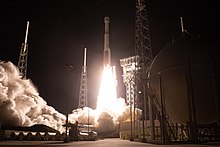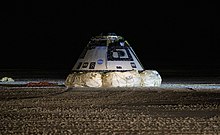Boe-OFT
| Mission dates | |||
|---|---|---|---|
| Mission: | Boe-OFT | ||
| Spacecraft: | CST-100 Starliner | ||
| Launcher: | Atlas V (N22) | ||
| Crew: | no | ||
| Begin: | December 20, 2019, 11:36 UTC | ||
| Starting place: | Cape Canaveral Air Force Station , SLC-41 | ||
| Space station: | ISS | ||
| Landing: | December 22, 2019, 12:58 UTC | ||
| Landing place: | White Sands Missile Range , New Mexico | ||
| Flight duration: | 2 days | ||
| Payload: | Test dummy "Rosie" | ||
| ◄ Before / After ► | |||
|
|||
The Boeing Orbital Flight Test , or Boe-OFT for short , was the first and still unmanned orbital test flight of the reusable US American spacecraft CST-100 Starliner . The spacecraft developed by the aerospace company Boeing was launched on December 20, 2019, two years late. After a two-day flight plagued by technical breakdowns, the capsule landed on Earth on December 22, 2019. The planned docking with the International Space Station (ISS) was not achieved. In April 2020, NASA and Boeing agreed to repeat the test flight .
The direct competitor SpaceX had already successfully docked with its Crew Dragon spacecraft on the ISS during the SpX-DM1 mission .
Mission history
The CST-100 Starliner was launched on December 20, 2019 at 6:36 a.m. local time in an Atlas V launcher from the SLC-41 launch pad at Cape Canaveral Air Force Station in Florida . As in the previous SpaceX test flight SpX-DM1 , there was an anthropomorphic test device equipped with about a dozen sensors , a test dummy named "Rosie", on one seat. The name should be reminiscent of Rosie the Riveter , a US advertising figure from the time of World War II, who is now considered a symbol of working women.
The launch vehicle carried the Starliner as planned on a suborbital orbit at an altitude of 180 km, from where it was to approach the International Space Station at an altitude of around 400 km and dock there. On December 28, the capsule was supposed to disconnect and land in the New Mexico desert .
Problems arose after the spaceship was separated from the upper stage of the rocket. An incorrect comparison of the Starliner on-board clock with the correctly working clock of the Atlas V launcher, which was carried out before take-off, resulted in the Starliner's attitude control engines burning far more fuel than planned. An intervention by the ground control made it possible to bring the spaceship into a stable earth orbit, but due to a lack of fuel, the ISS could no longer be approached. NASA and Boeing decided to end the mission early.
Other technical problems arose during the flight. Communication between the ground station and the spaceship failed several dozen times, apparently because of interfering radio signals when flying over one or more terrestrial transmitters. Loose objects floated around inside the spaceship. One of the engines failed and one of the three redundant control units of the inertial navigation system did not work as planned. Only a few hours before the return to earth was it possible to fix a serious error in the engine control, which could have led to the loss of the Starliner , by updating the software of the on-board computer. During landing, a valve on the nitrogen pressurization system for a fuel tank did not close.
The ultimately successful landing took place after 33 orbits around the world on December 22, 2019 at 5:58 a.m. local time on the White Sands Missile Range in the US state of New Mexico. It was the first US spacecraft to land on land since the last space shuttle mission, STS-135 . Earlier US missions, such as the Apollo missions or the competitor SpaceX, usually ended with a splash in the sea.
consequences
After this flight, NASA asked Boeing to perform a complete review of the software development processes and the around 1 million lines of program code in the Starliner on-board software. Overall, Boeing 80 is to implement "corrective measures". She also ordered an investigation into the company's corporate culture. In the financial statements 2019 Boeing introduced 410 million US dollars back for the repair work and the cost of a repeat of the unmanned test flight. It later emerged that Boeing had not fully tested the entire spacecraft and rocket system prior to launch, as is common practice.
Various observers, including a member of NASA's security oversight committee, drew parallels to software problems on the Boeing 737 MAX , which resulted in two crashes and the loss of 346 lives.
Web links
- NASA Update on Orbital Flight Test Independent Review Team , March 6, 2020
Individual evidence
- ↑ Boeing identifies CST-100 prime landing sites. In: Spaceflight Now. November 22, 2015, accessed March 4, 2019 .
- ↑ Test flight from the space capsule "Starliner" to the ISS failed orf.at, December 20, 2019, accessed December 20, 2019, 4:15 p.m. CET.
- ↑ Boeing to Fly Second Uncrewed Orbital Flight Test for NASA . NASA, April 6, 2020.
- ^ Atlas V to Launch Starliner. United Launch Alliance, accessed August 25, 2019 .
- ↑ Chris Gebhardt: Twitter report from a NASA presentation on October 30, 2019.
- ↑ Joey Roulette: Reuters report Boeing's Starliner test capsule fails in space station mission, accessed on December 20, 2019, 10:45 p.m.
- ↑ Loren Grush: The Verge Boeing's new Starliner spacecraft is in the wrong orbit during first trip to space, accessed on December 20, 2019, 10:45 p.m.
- ↑ Boeing Starliner Commercial Crew Update . YouTube video from Boeing, February 28, 2020; Minute 7-19.
- ^ Boeing Reports Fourth-Quarter Results . Boeing, January 29, 2020.
- ^ Jeff Foust: No decision yet on need for second Starliner uncrewed test flight . Spacenews, March 6, 2020.
- ^ " ASAP's Susan Helms: 19 additional action items added to the initial 61 from the review into Boeing's Orbital Flight Test mission ". Twitter message from Jeff Foust, May 15, 2020.
- ↑ Boeing didn't perform full end-to-end test of its astronaut capsule before troubled mission, 'surprising' NASA safety panel . Orlando Sentinel, February 26, 2020 (not available from Europe).

